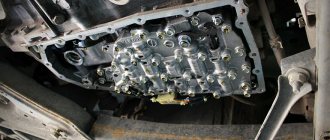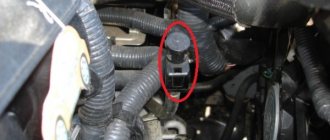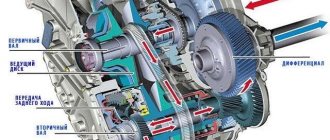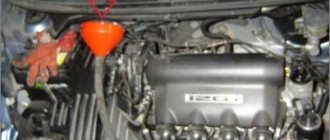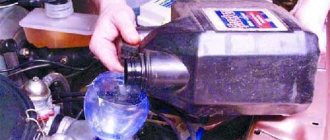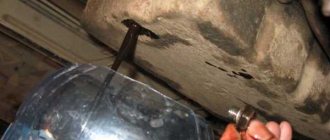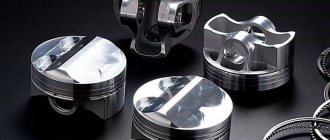On many modern cars (both passenger cars and SUVs) you can more and more often find a CVT variator instead of “classic” hydromechanical automatic transmissions. The fact is that CVTs, first of all, provide improved dynamic performance, are more economical, and this gearbox is also considered the most comfortable.
Note, like any other unit, the CVT also has its pros and cons, while many drivers prefer this particular type of automatic transmission. The serviceability and service life of the variator also directly depend on the quality of service and compliance with the rules during operation.
In this article we will look at how to change CVT oil, when it needs to be done, how to change the oil in a CVT gearbox, as well as what to look for when selecting lubricants, etc.
How does a continuously variable transmission work?
The variator is based on 2 expansion shafts and the drive element connecting them, that is, a belt or chain. Both shafts are connected to the gearbox oil system, through which the control unit regulates the compression ratio of each of them. The more strongly the drive shaft plates are compressed, the larger the diameter of rotation of the belt or chain on it, and therefore the smaller on the driven one. By changing the pressure in both shafts, the control unit changes the gear ratio within a wide range.
In addition, this type of transmission is equipped with:
- torque converter;
- planetary gearbox;
- friction clutch;
- an actuator (hydraulic unit) with hydraulic cylinders located inside the body, which makes it similar to traditional automatic transmissions, that is, hydraulic automatic transmissions and robotic transmissions (manual transmissions).
The torque converter acts as a clutch and converts the ratio of engine shaft speed to torque when the vehicle starts to move. The planetary gearbox switches the driving direction of the car (forward or backward). Frictions ensure the correct operation of the planetary gear, and on some transmissions they also serve as a clutch. The control unit located outside the transmission is the “brain” of the variator, performing the same functions as the ECU on a hydraulic automatic transmission, and the valve body cylinders, together with the oil pump, are the “arms” of this “brain”.
What to use for the variator
The choice of lubricant for CVT gearboxes is subject to increased requirements. Unlike engine oils, it is not recommended to use analogues or experiment with interchangeable compounds.
Always choose the oil for your CVT that is specified in the manufacturer's recommendations.
Many are sure that there is no difference between oils for a CVT and a classic automatic transmission, that is, a torque converter. This is a misconception.
ATF and CVTF lubricants solve slightly different problems. Automatic transmission oils are aimed at ensuring hydraulic transformation of torque and providing lubrication for internal moving elements.
And oils for the variator lubricate and prevent the pulley from slipping. Because of this, the two types of lubricants differ significantly in composition and properties.
ATF and CVTF oils are completely incompatible with each other.
The only correct solution is to look at the instruction manual and find out which lubricant is suitable for the specific variator installed on the car.
Each auto company offering cars with CVT has its own recommended lubricants. Here are some examples:
- For Nissan vehicles, use CVT lubricants labeled NS1, NS2 and NS3.
- For these Japanese cars, the current version of the required oil is called Fluid J4. Although previously it was recommended to use Fluid J1. Oils are considered interchangeable.
- The Japanese company offers 2 types of lubricants for its machines. These are Fluid FE and Fluid TC. They have different markings and characteristics. They differ in additives. The FE version is more modern and can be used together with the conventionally outdated TC.
- HCF2 and HMMF lubricants are offered for these cars. But it is important to consider that they are not interchangeable.
- CVTs are also installed here, and they require G052 180A2 oil. The only regulated analogue is Febi 27975. The same lubricants are suitable for CVT on Volkswagen, Skoda and Seat cars.
- It is recommended to fill in different lubricants, depending on the model. CVT Lineatronic II composition is suitable for Lineatronic boxes. A special C30 fluid is supplied to the USA. ICVT FG lubricants are suitable for Subaru small cars.
- Elfmatic CVT oils are used here. An analogue is oil from Nissan NS2.
What spoils oil
The main sources of ATP contamination are clutches and shafts with a belt or chain. Every time you start moving, the clutches experience increased loads, which is why part of the lining coating turns into dust and gets into the oil. The higher the load during start, the more the friction layer is destroyed and the more dust gets into the fuel fluid.
Oil for variator in cars
The shafts and belt or chain are in constant mesh, so their surface wears down over time, turning into fine steel dust. Under sudden or high loads, the belt or chain slips a little, causing metal shavings to appear. In addition, all rubbing parts become very hot, which leads to oxidation of the fuel fluid and the formation of soot, which also ends up in the oil.
ATF fluid life
The oil in an automatic gearbox performs the following functions:
- lubricates plain bearings and other friction pairs inside the automatic transmission;
- removes heat from heating elements. Thanks to the constant circulation of oil, the thermal balance inside the unit is maintained;
- serves as a working fluid for the automatic transmission torque converter and valve body. With the help of oil, torque is transmitted from the engine, the clutch packs close and open.
With such multitasking, the concept of a fixed ATF fluid life is not applicable to automatic transmissions. The physicochemical properties of the oil strongly depend on the operating mode of the vehicle and the serviceability of individual automatic transmission components. The oil service life is most affected by temperature conditions and the degree of saturation with wear products of gearbox parts.
If individual automatic transmission components regularly overheat due to heavy load or malfunction, ATF fluid quickly loses its viscosity stability, and the properties of lubricating and anti-corrosion additives deteriorate.
During vehicle operation, the automatic transmission oil inevitably becomes saturated with wear products from the friction pairs inside the automatic transmission. First of all, we are talking about clutch packs, during the operation of which slipping modes between the friction and metal discs are inevitable. The consequence of this work is that friction dust, fine metal shavings and the adhesive composition used in the production of friction clutches get into the oil. With a combination of gearbox malfunctions and heavy operating conditions of the car, even new oil will become unusable after 15-30 thousand km.
Malfunctions that reduce the service life of the oil in the automatic machine:
- insufficient oil pressure in the valve body;
- worn clutch packs;
- malfunction of the automatic transmission cooling system (bent oil circulation tubes, clogged heat exchanger);
- valve body malfunction.
Change of oil
The technique for replacing the hydraulic fluid is in many ways similar to that used for traditional hydraulic automatic transmissions (Changing the oil in an automatic transmission), so there are 3 types of it:
- partial;
- double partial;
- hardware (full).
Partial replacement can be done manually, without contacting service, which is a significant advantage, but the disadvantage of this method is that only 50-60% of the old fluid can be removed, and the rest will mix with the new ATP and worsen its properties. A double partial and hardware oil change in a variator is carried out in the same way as on an automatic transmission, that is, a double means two partial ones, carried out one after the other, and a complete one only with the help of a special stand (device).
Here's one real drawback:
Actually, this is not a drawback - this is a normal limitation for civilian, and not specially prepared racing cars.
If you start from each traffic light “like the last time,” and even with the variator not warmed up, then scuffing will appear on the rubbing elements of the belt and on the working surfaces of the cones. The resource of the unit will be enough for thousands of twenty kilometers, or even less. And no superfluid can save you from this phenomenon. The variator is not for street racing feats, but for the most comfortable movement
. If you want to drive, there are special cars and, by the way, special tracks for that.
It is likely that in the near future the CVT will be installed on at least half of the cars produced. So treat it with care, change the working fluid - and then the variator will last a long time.
- The whole truth about the (un)reliability of CVTs is in this publication.
Photo: manufacturing companies
Partial replacement
A partial oil change in the variator consists of the following steps:
- waste drain;
- filter replacement;
- cleaning the tray;
- transmission condition assessment;
- pouring a new fuel tank.
Draining waste
Roll the car onto a pit or overpass and unscrew the drain plug. Remember, warming up the box makes it easier to drain the waste, but on some machines this cannot be done due to the sensitivity of the valve body to temperature changes. In addition, some variators are equipped not only with a drain plug, but also with a measuring tube (sometimes called a “check”), so after unscrewing the plug, use a suitable hexagon to unscrew the measuring tube, after which the oil will flow down.
Draining waste from the variator
Collect waste in a clean, transparent container; this will help you assess the condition of the unit and make the right decision about its future fate. When the ATP stops dripping, remove the pan to access the valve body and remove some more fluid.
Replacing filters
Typically, boxes of this type have 2 oil filters - internal and external. The internal one is located in the pallet; depending on the design of the unit and the availability of parts, it is changed together with the pallet or separately. The external filter is located on the outside of the box and is changed every time the CVT is serviced, with the method of replacement depending on the design of the transmission. Both parts can be purchased as a set or separately.
Cleaning the tray
There are 2-3 magnets attached to the bottom of the pan, which act as additional oil filters that catch metal dust or shavings. Therefore, after draining the oil, the magnets look like hedgehogs, covered with needles on all sides.
The easiest way to clean the pan of old grease residue is to use a high-pressure washer and chemicals for external engine washing.
If you suspect that the magnets are not catching all the metal debris, install a couple more elements that are available at most car dealerships. After cleaning the pan with a high pressure washer, dry the part with compressed air. Do not even wipe it with a clean cloth, otherwise the dust from it will turn the ATP into an abrasive liquid.
Transmission Condition Determination
To determine the condition of the variator, evaluate the color and smell of the oil. If it is much darker than it was originally, then the clutches, and possibly other parts, require replacement. Most likely this was due to overheating of the transmission caused by sudden starts or high-speed driving. The presence of many small bubbles in the exhaust indicates that the unit was operating with an incorrect level of transmission fluid, which means it is advisable to carry out diagnostic repairs. If the oil in the box has a normal color and smell, then the unit is working properly and therefore does not require any intervention.
Filling with new fluid
Before adding new transmission fluid, follow these steps:
- Reinstall the pan with a new gasket.
- Screw in the measuring tube and stopper.
- Pour in liquid.
To fill, use one of the following holes:
- drain;
- aspic (control);
- breather;
- seat of the external filter.
When choosing a place to fill the oil, refer to the operating manual (instructions) for your machine. If it is recommended to use some equipment, then purchase it, because the standard filling method is much more convenient.
Misconception The variator is unreliable and cannot be repaired
There is no more terrible and widespread myth about CVTs. But in fact, years of operation and cars with high and very high mileage prove the opposite. Most CVTs run for 150,000 km or more. Problems arise either among those who like to “jeep” or among street racers. The CVT lives longer with a calm driving style, without extreme acceleration. And the working fluid in it must be changed regularly. Only under these conditions can a variator be placed on a par with hydromechanical automatic machines in terms of reliability. Also, do not forget to keep the radiators that cool the variator fluid clean.
.
In cold weather, it is advisable to warm up the variator, like the engine itself
. In the place where the cones and the belt come into contact, the liquid begins to work normally only at a temperature close to the operating temperature. When the fluid is cold, slippage will occur, which will cause scoring on the surface of the cones and belt.
Suppose the variator begins to show the first signs of wear. There were jerks when moving, a grinding noise at low speeds, not quite smooth acceleration, and in general the behavior of the variator changed. If you start repairs at an early stage of damage to the main parts, you can get by with a relatively inexpensive repair. Of course, repairing a variator is not cheap, but usually it costs 50,000 - 70,000 rubles. This amount includes replacing the belt, grinding or replacing the cones, replacing the bearings and checking the pump valve. In most cases, simple hydromechanical automatic machines are cheaper to repair.
***
Dual and hardware replacement
Both types of oil changes in the variator box ensure maximum removal of ATP from the torque converter. However, the amount of new fluid should be:
- 2 times more for double;
- 3–5 times more for hardware replacement.
The only advantage of double replacement is that you can do it yourself, but the effectiveness of the hardware method is much higher. Experienced technicians recommend the following procedure for changing the oil in the variator with an interval of 40 thousand km:
- partial;
- double;
- complete.
That is, with a mileage of 40 thousand km, a partial replacement is carried out, when the car has passed 80 thousand, a double replacement is performed, and when the vehicle has passed 120 thousand, a hardware replacement is performed. This procedure, coupled with careful driving, ensures a service life of the variator of 150–200 thousand km before repair or replacement.
When to change the oil in the variator
Replacing the lubricant in the variator is carried out in strict accordance with the regulations, which each automobile manufacturer has its own. On average, it is recommended to carry out maintenance at least once every 40 thousand kilometers.
The replacement interval is reduced if the vehicle is operated in unfavorable conditions:
- regular and prolonged towing of trailers or other vehicles;
- dynamic driving style with fast acceleration and braking;
- long periods of vehicle idle time in traffic jams at high air temperatures;
- frequent wheel slip and movement over rough terrain;
- operating the car in the mountains, driving on dusty and/or dirty roads.
If a check light lights up on the dashboard or a hum is heard while driving, there is vibration or an unpleasant burning smell appears - these are good reasons to check the level and condition of the oil in the CVT (continuously variable transmission).
Which type of oil change is preferable?
Sometimes inexperienced drivers ask which type of oil change is preferable if the variator has already begun to jerk or slip.
In such conditions, it makes no difference whether a partial or complete oil change in the variator will be made, because the transmission is already worn out and needs repair.
And filling in new ATP will not affect its technical condition in any way, which means it will only be a pointless waste of finances. Therefore, it is necessary to change the transmission fluid before symptoms of transmission failure appear.
How to check the level and make sure it needs to be replaced?
The oil level in the automatic transmission can be checked by unscrewing the plug of the measuring hole or using a dipstick (not installed on all types of automatic transmissions). While checking, you can apply a drop of oil to a clean napkin. This way you can indirectly determine the presence of wear products and signs of overheating. If operating temperatures are exceeded for long periods, the oil emits a strong, burnt odor.
When choosing a new oil for an automatic transmission, be guided not only by the class of the working fluid, but also by the individual specifications from the automatic transmission manufacturer.
Video: Changing the oil kills the automatic transmission. Or not?
CVT - design features
Instead of a three-dimensional set of shafts, gears and rocker arms, the variator consists of two pulleys with a variable gear ratio. By the way, compactness is the main virtue of this type of gearbox.
Scheme of operation of the variator
The operating principle is as follows: From the engine to the drive shaft (in other words, directly to the wheel hubs), torque is transmitted using a specially designed V-belt.
Some experts call this belt a chain drive. In part, they are right, since it is a set of metal links connected to each other in a special way.
The gear ratio (which changes the speed of rotation of the transmission shaft) varies due to synchronous changes in the diameters of the pulleys. The figure shows that by moving and spreading the “cheeks” of the pulleys, it is possible to regulate the speed of the wheels with high precision.
But to compress and hold these halves, transmission oil specially designed for CVTs is used.
The liquid is pumped into cylinders located on the same axis with the pulleys and compresses the halves with monstrous force. At the same time, the amount of oil in the second cylinder is reduced to just enough volume to ensure compression force and geometry.
In addition, this entire structure must be continuously lubricated at the points of contact between the belt (chain) and the pulley. At the same time, cooling is provided: the constant friction of metal on metal greatly heats the variator mechanism.
To be fair, one gear pair is still present. This is the reverse gear mechanism. No separate lubrication is required - the unit is “bathed” in the common transmission.
How to choose high-quality transmission fluid for a CVT
Information about the transmission fluid that is suitable for your vehicle's CVT can be found in the vehicle's service manual, vehicle service book, or directly on the continuously variable transmission dipstick, which can be found under the hood of the car. It is there that the factory approval is indicated, which will help you choose the highest quality oil for the variator of your vehicle.
For example, Nissan brand CVTs are filled with oil with NS-1, NS-2 or NS-3 approvals.
For CVT Toyota, it is recommended to use transmission fluid with the specification CVT Fluid TC or CVT Fluid FE.
HMMF factory approval helps you select high-quality transmission fluid for continuously variable transmissions in Honda vehicles.
And for CVT cars of the Mitsubishi brand, the oil is selected according to the CVT Fluid J1 or CVT Fluid J4 tolerances.
About the filter
Some people noticed that I highlighted the word filter in the paragraph above. For what? I would like to draw your attention to them. This is another vital element (or rather elements) in the gearbox system. There are both two and one, the so-called coarse cleaning and fine cleaning.
A fine filter is a regular paper filter, somewhat similar to a car oil filter.
Coarse cleaning is metal, usually in a flat housing.
For the sake of fairness, I want to point out once again - there is also one in “metal”, everything there is combined, both “rough” and “fine”.
They are needed to catch chips, dirt, burnt marks, etc. formed during work, there is no escape from this.
That is, to summarize - the oil (liquid) is cleaned and cooled during operation, this is important to understand.
Method one or change the oil without draining
This method is now used by a large number of stations, dealerships, “handicraft-garage” ones, it doesn’t matter. Let me remind you that in an ordinary automatic transmission, the fluid is approximately 8 - 10 liters, again it all depends on the manufacturer and features.
The point is simple - at the bottom of the machine there are almost never “plug holes” for draining oil; they are located either on the side or on top. You cannot drain the oil completely! If you unscrew the side hole, at best half of it will leak out, and not always. Therefore, the oil is pumped out to the middle (from the side or from above), that is, approximately 4 - 5 liters, leaving half of the old one.
Then the same amount of new is added, the whole thing is mixed with the old. Afterwards, they either let you ride for another 500 - 1000 kilometers, or you simply switch gears, mixing the oil right on the lift. Then the oil is drained again, the same 4 - 5 liters and new is added again.
Thus, almost 80–90% of the liquid changes, but some still remains dissolved.
AND NOW THE TRUTH - well, we drained the oil, filled in new one, and the liquid itself also wears out and burns (becomes dark), but that’s only half the battle! After all, in fact, the shavings remained at the bottom (on the magnet), the filters have not been changed (that is, they may be clogged), and the radiator also has no idea what condition it is in!
The only advantage we can note is that all this sediment from the bottom of the box is not raised, that is, we drain the oil without disturbing it! Well, the magnet holds it and it’s good, we even remove the honor with the old liquid. But this is NOT THE RIGHT WAY!
